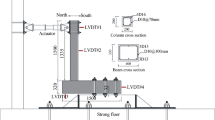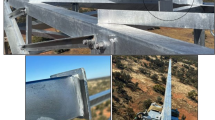Abstract
This paper investigates the behaviour of damaged steel beams repaired using locally pre-stressed reinforcing steel bars. Regular reinforcing bars are welded to the beam’s web at both ends and then pretensioned using a manual screw jack to increase the effectiveness of the repair. Six beams with different bar diameters and levels of pre-stress were repaired and tested under three-points bending. Results showed that the level of pre-stress controlled the beams’ stiffness, while restoration of their ultimate load-carrying capacity was governed by the bar size. Significantly higher repaired capacities were achieved by this method than by other published methods used for the strengthening of steel beams.
Similar content being viewed by others
References
Ayyub, B. M., Sohn, Y. G., and Saadatmanesh, H. (1992). “Prestressed composite girders. II: Analytical study for negative moment.” Journal of Structural Engineering, 118, pp. 2763–2782.
Chen, S. (2005). “Experimental study of prestressed steelconcrete composite beams with external tendons for negative moments.” Journal of Constructional Steel Research, 61, pp. 1613–1630.
Chen, S. and Gu, P. (2004). “Load carrying capacity of composite beams prestressed with external tendons under positive moment.” Journal of Constructional Steel Research, 61, pp. 515–530.
Colombi, G. and Poggi, C. (2006). “An experimental, analytical and numerical study of the static behavior of steel beams reinforced by pultruded CFRP strips.” COMPOSITES PART B-ENGINEERING, 37, pp. 64–73. doi: 10.1016/j.compositesb.2005.03.002
Deng, J. and Lee, M. (2009). “Adhesive bonding in steel beams strengthened with CFRP.” Proc. Institution of Civil Engineers-Structures and Buildings, 162, pp. 241–249. doi: 10.1680/stbu.2009.162.4.241
Hmidan, A., Kim, Y. J., and Azdani, S. (2011). “CFRP repair of steel beams with various initial crack configurations.” Journal of Composites for Construction, 15(6), pp. 952–962. doi: 10.1061/(asce)cc.1943-5614.0000223
Jiao, H., Mashiri, F., and Zhao, X. (2012). “A comparative study on fatigue behaviour of steel beams retrofitted with welding, pultruded CFRP plates and wet layup CFRP sheets.” Thin-Walled Structures, 50, pp. 144–152. doi: 10.1016/j.tws.2012.06.002
Kim, Y. J. and Brunell, G. (2011). “Interaction between CFRP-repair and initial damage of wide-flange steel beams subjected to three-point bending.” Composite Structures, 93, pp. 1986–1996. doi: 10.1016/j.compstruct.2011.02.024
Kim, Y. J., Green M. F., and J., F. G. (2008). “Repair of bridge girder damaged by impact loads with prestressed CFRP sheets.” Journal of Bridge Engineering, 13, pp. 15–23. doi: 10.1061/(ASCE)1084-0702(2008)13:1(15)
Kim, Y. J. and Harries, K. A. (2012). “Predictive response of notched steel beams repaired with CFRP strips including bond-slip behavior.” International Journal of Structural Stability and Dynamics, 12, pp. 1–21. doi: 10.1142/S0219455412004628
Kim, Y. J. and Yoon, D. K. (2010). “Identifying critical sources of bridge deterioration in cold regions through the constructed bridges in North Dakota.” Journal of Bridge Engineering, 15, pp. 542–552. doi: 10.1061/(ASCE)BE.1943-5592.0000087
Lenwari, A. (2006). “Debonding strength of steel beams strengthened with CFRP plates.” Journal of Composites for Construction, 10(1), pp. 69–78. doi: 10.1061/(asce)1090-0268(2006)10:1(69)
Mosley, B., Bungey, J., and Hulse, R. (2007). Reinforced concrete design to Eurocode 2. Palgrave Macmillan, New York.
Nie, J., Tao, M., Cai, C. S., and Li, S. (2011). “Analytical and numerical modeling of prestressed continuous steelconcrete composite beams.” Journal of Structural Engineering, 137, pp. 1405–1418.
Nozaka, K., Shield, C. K., and Hajjar, J. F. (2005). “Effective bond length of carbon-fiber-reinforced polymer strips bonded to fatigued steel bridge I-girders.” Journal of Bridge Engineering, 10, pp. 195–205. doi: 10.1061/(ASCE)1084-0702(2005)10:2(195)
Photiou, N. K., Hollaway, L. C., and Chryssanthopoulos, M. K. (2006). “Strengthening of an artificially degraded steel beam utilising a carbon/glass composite system.” Construction and Building Materials. doi: 10.1016/j.conbuildmat.2005.06.043
Qader, A. H., Agarwal, V. C., and Ibrahim, A. M. (2013). “Nonlinear behavior of continuous composite steel concrete beam with external prestress.” International Journal of Innovative Technology and Exploring Engineering, 3(7), pp. 76–82.
Roy, M., Lang, C., and May, I. M. (2009). “Modelling composite repairs to cracked metal structures.” Proc. Institution of Civil Engineers-Structures and Buildings, 162, pp. 107–113. doi: 10.1680/stbu.2009.162.2.107
Rusch, H., Jungwirth, D., and Hilsdorf, H. K. (1983). Creep and shrinkage: Their effect on the behavior of concrete structures. Springer-Verlag New York Inc., New York.
Shagin, A. L. (1996). “Locally post-tensioned constructions.” Scientific and Practical Challenges of Modern Reinforced Concrete, 48, pp. 193–196.
Shagin, A. L. (2005). “Local post-tensioning of concrete and composite structures.” Scientific and Practical Challenges of Modern Reinforced Concrete, 52, pp. 107–116.
Shahrooz, B. M., Saraf, V., Godbole, B., and Miller, R. A. (2002). “Response of slab bridges before, during, and after repair.” Journal of Bridge Engineering, 7, pp. 267–275.
Tavakkolizadeh, M. and Saadatmanesh, H. (2003). “Repair of damaged steel-concrete composite girders using carbon fiber-reinforced polymer sheets.” Journal of Composites for Construction, 7(4), pp. 311–322. doi: 10.1061/(asce)1090-0268(2003)7:4(311)
Uy, B. (2007). Modern design, construction and maintenance of composite steel-concrete structures: Australian experiences. Paper presented at the 1st International Conference on Modern Design, Construction and Maintenance of Structures, Hanoi, Vietnam.
Uy, B. and Craine, S. (2004). “Static flexural behaviour of externally post-tensioned steel-concrete composite beams.” Advances in Structural Engineering, 7, pp. 1–20.
Wardhana, K. and Hadipriono, F. (2003). “Analysis of recent bridge failures in the United States.” Journal of Performance of Constructed Facilities, 17, pp. 144–150. doi: 10.1061/(ASCE)0887-3828(2003)17:3(144)
Xue, W., Ding, M., He, C., and Li, J. (2008). “Long-term behavior of prestressed composite beams at service loads for one year.” Journal of Structural Engineering, 134, pp. 930–937.
Xue, W. C. and Li, J. (2001). “Studies on performance of prestressed steel-concrete composite beams.” Paper presented at the OUR WORLD IN CONCRETE & STRUCTURES, Singapore.
Author information
Authors and Affiliations
Corresponding author
Rights and permissions
About this article
Cite this article
Taoum, A., Jiao, H. & Holloway, D. Using locally pre-stressed reinforcing bars to restore the capacity of severely damaged steel beams. Int J Steel Struct 15, 125–134 (2015). https://doi.org/10.1007/s13296-015-3009-1
Received:
Accepted:
Published:
Issue Date:
DOI: https://doi.org/10.1007/s13296-015-3009-1




